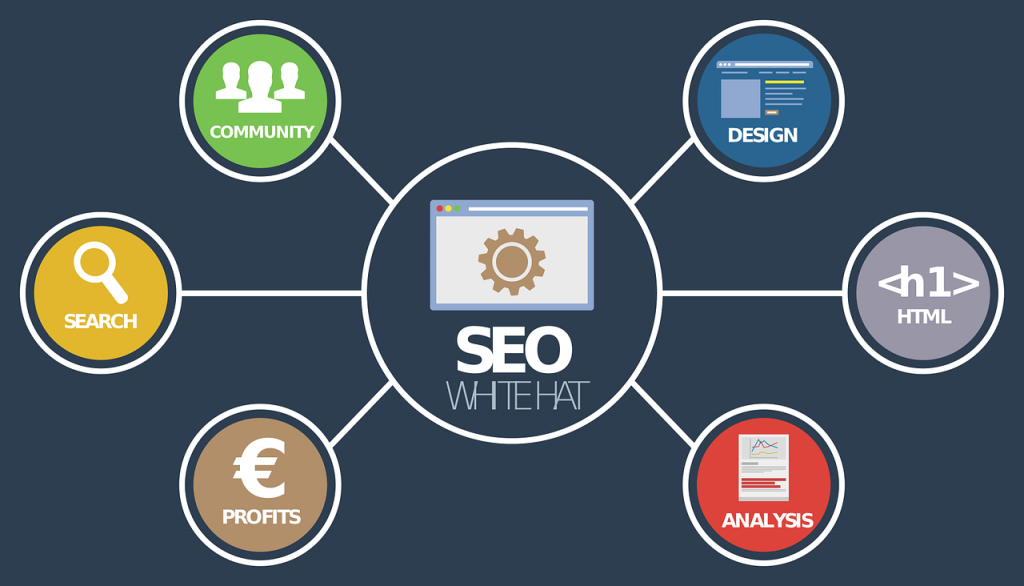Have you ever wondered how Google Ads plays a crucial role in content marketing? In today’s digital landscape, where businesses are constantly vying for attention online, effective content marketing strategies are essential for success. And Google Ads, with its vast reach and targeting capabilities, has emerged as a powerful tool to amplify your content and reach the right audience. In this article, we will explore the various ways in which Google Ads can enhance your content marketing efforts, from increasing brand visibility to driving website traffic and generating leads. Get ready to uncover the untapped potential of Google Ads in content marketing.

Differentiating Google Ads and Content Marketing
Google Ads and content marketing are two powerful strategies that businesses can use to reach and engage their target audience. While they both aim to achieve similar goals, it is essential to understand the differences between the two and how they can complement each other in an integrated marketing approach.
Understanding the Purpose of Google Ads
Google Ads, formerly known as Google AdWords, is an online advertising platform provided by Google. Its primary purpose is to help businesses display targeted ads to users who are actively searching for specific products, services, or information on the search engine. Google Ads allows advertisers to bid on keywords and create compelling ad copies to be shown to relevant searchers. The goal of Google Ads is to drive targeted traffic and conversions to a website or landing page.
Exploring the Goals of Content Marketing
Content marketing, on the other hand, focuses on creating and distributing valuable, relevant, and consistent content to attract, engage, and retain a specific audience. The main objectives of content marketing include building brand awareness, establishing thought leadership, educating the audience, nurturing relationships, and ultimately driving profitable customer action. Content can come in various formats such as blog posts, articles, videos, infographics, podcasts, and more.
Identifying the Overlaps between Google Ads and Content Marketing
While Google Ads and content marketing may seem like distinct strategies, there are areas where they overlap and can work together harmoniously. For instance, both aim to reach and engage the target audience. Google Ads achieves this by showing ads to users actively searching for relevant keywords, while content marketing seeks to capture the attention of the audience through valuable and engaging content.
Additionally, both Google Ads and content marketing rely on keyword research to guide their targeting efforts. Google Ads advertisers select keywords for their ad campaigns, while content marketers use keywords to optimize their content for search engine visibility. By aligning their keyword strategies, businesses can create a cohesive approach to capturing their audience’s attention.
Integration of Google Ads and Content Marketing Strategies
Integrating Google Ads and content marketing strategies can yield even greater results than using them individually. Here are some ways businesses can leverage both strategies to enhance their marketing efforts:
Leveraging Google Ads for Content Promotion
Google Ads can be a powerful tool for promoting content. By creating ads that drive traffic to valuable and relevant content, businesses can attract targeted users who are more likely to engage with their brand. For example, businesses can create ads that lead users to blog posts, videos, or other content assets that provide valuable information or address a pain point. This not only helps drive engagement but also establishes the business as a credible source of information in their industry.
Using Content Marketing to Enhance Google Ads Campaigns
Content marketing can play a crucial role in enhancing the effectiveness of Google Ads campaigns. By creating high-quality, relevant content that aligns with the keywords targeted in the ads, businesses can improve their ad relevancy and user experience. For example, businesses can create landing pages with in-depth content that expands on the ad’s messaging and provides additional value to the users. This helps increase ad engagement and conversions.
Creating Consistency in Messaging and Branding
Integrating Google Ads and content marketing requires ensuring consistency in messaging and branding across both strategies. It is essential to maintain a cohesive brand voice, design elements, and value proposition throughout all touchpoints. This consistency helps build brand recognition and trust among the audience. For example, businesses can use similar messaging and design elements in their ad copies and content assets to create a seamless experience for users.
Benefits of Incorporating Google Ads into Content Marketing
By incorporating Google Ads into their content marketing strategy, businesses can reap several benefits that can contribute to their overall marketing success. Here are some key advantages:
Increased Reach and Visibility
Google Ads provides businesses with the opportunity to reach a broader audience by displaying targeted ads to users who are actively searching for related keywords. This increased reach can help businesses expand their brand presence and attract new potential customers. Additionally, Google Ads allows businesses to display their ads on Google’s advertising network, increasing their visibility on popular websites and mobile apps.
Effective Targeting and Personalization
With Google Ads, businesses can leverage sophisticated targeting options to reach their ideal audience. They can target specific keywords, demographics, locations, interests, and more to ensure their ads are shown to the most relevant users. This targeted approach allows for personalized messaging and increases the chances of attracting users who are more likely to convert into customers.
Higher Conversion Rates and ROI
One of the biggest advantages of incorporating Google Ads into content marketing is the potential for higher conversion rates and return on investment (ROI). Google Ads allows businesses to track and measure their advertising campaigns’ performance, providing insights into which keywords, ads, and landing pages are driving the most conversions. By optimizing campaigns based on this data, businesses can maximize their conversion rates and achieve a higher ROI.
Optimizing Google Ads for Content Marketing
To make the most out of Google Ads in content marketing, certain optimization techniques can be implemented. Here are some strategies to optimize Google Ads for content marketing success:
Keyword Research and Selection for Content Marketing
Effective keyword research is crucial for both Google Ads and content marketing. For content marketing, businesses should focus on identifying keywords with high search volume and low competition that align with their target audience’s interests and pain points. These keywords will inform the content creation process and ensure the content resonates with the target audience. Additionally, incorporating long-tail keywords can help capture more specific searches and attract highly targeted traffic.
On the Google Ads side, advertisers should conduct thorough keyword research to identify relevant keywords with high commercial intent. These keywords should align with the content the business wants to promote. By selecting the right keywords, advertisers can improve ad relevance, increase click-through rates, and attract users who are more likely to engage with their content.
Ad Copy and Landing Page Alignment
Aligning ad copy with landing page content is crucial for maintaining a consistent user experience and ensuring ad relevancy. Businesses should create ad copies that clearly and accurately reflect the content they are promoting. This clarity helps manage user expectations and reduces the chances of high bounce rates or low engagement. Ad copy should be compelling, concise, and tailored to resonate with the target audience’s interests and pain points.
Similarly, landing pages should deliver on the promises made in the ad copy. The content on the landing page should provide further information, value, or solutions to the users’ needs. This alignment between ad copy and landing page content helps improve user experience, increase engagement, and enhance conversion rates.
Optimizing Landing Pages for Higher Engagement
To optimize landing pages for higher engagement, businesses should focus on several key elements. Firstly, the landing page should have a clear and compelling headline that grabs the user’s attention and communicates the value proposition. It should also have informative and persuasive content that clearly conveys the key messages and benefits.
Additionally, businesses should ensure that the landing pages are visually appealing, responsive, and easy to navigate. Optimizing page load speed is crucial to prevent user frustration and high bounce rates. Including relevant images, videos, and calls to action (CTAs) can also help increase engagement and guide users towards desired actions.

Measuring Success: Key Metrics for Google Ads in Content Marketing
Measuring the success of Google Ads in content marketing campaigns requires tracking and analyzing key metrics. Here are some essential metrics that businesses should pay attention to:
Click-Through Rates (CTR) and Ad Impressions
Click-through rate (CTR) measures the percentage of people who click on an ad after seeing it. It is an important metric to assess ad performance and relevance. High CTR indicates that the ad is resonating with the target audience and attracting clicks. On the other hand, a low CTR may indicate that the ad needs optimization or that it is not reaching the right audience. Ad impressions refer to the number of times an ad is displayed to users.
Conversion Rates and Cost Per Acquisition (CPA)
Conversion rate measures the percentage of users who take a desired action, such as making a purchase or filling out a form, after clicking on an ad or interacting with the content. It is a crucial metric to determine the effectiveness of both ads and content marketing efforts. Businesses should track conversion rates to identify which keywords, ads, and content assets are driving the most conversions.
Cost per acquisition (CPA) represents the average cost businesses incur to acquire a customer through their advertising efforts. It is calculated by dividing the total advertising cost by the number of conversions. Monitoring and optimizing CPA is essential to ensure that businesses are maximizing their advertising budget and achieving a favorable return on investment.
Engagement Metrics and Time on Site
Engagement metrics, such as bounce rate, average time on site, and pages per session, provide insights into how users are interacting with the content after clicking on an ad. Bounce rate measures the percentage of users who leave the website or landing page after viewing only one page. Businesses should aim for a low bounce rate, as it indicates that users are finding value in the content and navigating to additional pages.
Average time on site and pages per session give an indication of the level of user engagement and interest. Higher values for these metrics suggest that users are spending more time consuming the content, exploring additional pages, and potentially converting. By monitoring and analyzing these engagement metrics, businesses can make data-driven decisions to optimize their content marketing and ad strategies.
Challenges and Considerations for Google Ads in Content Marketing
While integrating Google Ads into content marketing can yield significant benefits, there are also challenges and considerations that businesses must address. Here are some key areas to be mindful of:
Balancing Budget Allocation between Advertising and Content Creation
One challenge businesses face is allocating their marketing budget effectively between advertising and content creation. Google Ads requires a budget for ad spend, while content marketing entails investing in producing quality content. Striking the right balance is crucial to ensure that both strategies receive adequate resources. Businesses should consider their overall marketing goals, target audience preferences, and the cost-effectiveness of each strategy when making budget allocation decisions.
Ensuring Quality and Relevance of Ads and Content
Maintaining the quality and relevance of both ads and content is essential to achieve success in the integration of Google Ads and content marketing. Ads should be well-crafted, engaging, and directly related to the content being promoted. Similarly, content assets should be informative, well-researched, and address the needs and interests of the target audience. Regular content audits and ad optimizations can help ensure that the messaging remains updated and aligned with the target audience’s expectations.
Continuous Monitoring and Optimization
To maximize the effectiveness of Google Ads in content marketing, businesses need to continuously monitor and optimize their campaigns. This requires analyzing performance metrics, staying updated with industry trends, and making data-driven adjustments. It is important to regularly review ad performance, landing page engagement, and content effectiveness to identify areas for improvement. By consistently optimizing their campaigns, businesses can enhance their overall marketing outcomes.

Strategies for Effective Google Ads and Content Marketing Integration
To successfully integrate Google Ads and content marketing, businesses should employ the following strategies:
Developing a Holistic Marketing Strategy
Integrating Google Ads and content marketing requires a holistic approach to marketing strategy. Businesses should clearly define their marketing goals, target audience personas, and the role of each strategy in achieving those goals. A cohesive marketing strategy ensures that both Google Ads and content marketing efforts work towards the same objectives, reinforcing each other’s impact.
Aligning Target Audiences and Buyer Personas
Successful integration of Google Ads and content marketing requires a deep understanding of the target audience. Businesses should align their target audience profiles and buyer personas across both strategies. This alignment ensures that ads and content are personalized and resonate with the intended audience. By consistently delivering valuable and relevant messaging, businesses can build trust, credibility, and loyalty among their target audience.
Creating an Editorial Calendar and Content Plan
An editorial calendar and content plan are essential for effective integration of Google Ads and content marketing. A well-structured content plan helps businesses organize their content creation efforts, align them with targeted keywords, and ensure consistent messaging. The editorial calendar provides a strategic roadmap for content creation and promotion, allowing businesses to outline timelines, assign responsibilities, and maintain a steady flow of valuable content.
Case Studies: Successful Google Ads and Content Marketing Campaigns
Examining successful case studies can provide insights into how businesses have effectively integrated Google Ads and content marketing. Here are a few examples:
Google Ads Supporting Content Promotion and Engagement
A software company launched a content marketing campaign to promote their new product. They created a series of blog posts and videos that provided valuable insights and tutorials related to their product’s features. To increase visibility and attract their target audience, they ran Google Ads campaigns targeting keywords relevant to their content. The ads led users directly to the blog posts and videos, resulting in increased website traffic, engagement, and product conversions.
Content Marketing Driving Higher Quality Google Ads Leads
An e-commerce retailer utilized content marketing to educate their target audience and establish themselves as industry experts. They created comprehensive buying guides and comparison articles featuring their products. To drive targeted traffic and capture leads, they implemented Google Ads campaigns targeting product-related keywords. The ads directed users to the relevant content, where they could learn more about the products and make informed purchasing decisions. This integration resulted in higher-quality leads, increased conversions, and improved ROI.
Synergy in Google Ads and Content Marketing Efforts
An online education platform combined Google Ads and content marketing to increase brand awareness and attract new students. They created engaging and informative video content that addressed common concerns and questions about pursuing online education. In conjunction with their content marketing efforts, they ran Google Ads campaigns targeting keywords related to online learning and career advancement. The ads linked to landing pages that provided additional information and encouraged users to sign up for their courses. This synergy between Google Ads and content marketing resulted in significant brand exposure, increased website traffic, and a surge in course enrollments.

The Importance of Expertise in Managing Google Ads for Content Marketing
Managing Google Ads for content marketing requires expertise and a deep understanding of both strategies. Here are some reasons why entrusting the management to experts can be beneficial:
Navigating the Complexities of Google Ads
Google Ads can be complex, with numerous features, settings, and optimization techniques to master. It requires a thorough understanding of ad formats, bidding strategies, targeting options, and measurement tools. Experts can navigate these complexities and implement strategies that maximize the effectiveness of Google Ads for content marketing campaigns.
Staying Up-to-Date with Algorithm Updates
Google continuously updates its search algorithms, which can impact the performance and visibility of Google Ads. Staying up-to-date with these updates is crucial to ensure that ads remain relevant, compliant, and effective. Experts dedicated to managing Google Ads stay informed about algorithm changes and adjust strategies accordingly to maintain optimal campaign performance.
Utilizing Advanced Targeting and Optimization Techniques
Experts in managing Google Ads have in-depth knowledge of advanced targeting and optimization techniques. They can utilize tools and features such as remarketing, demographic targeting, ad scheduling, and bid management to enhance the targeting precision and efficiency of campaigns. By leveraging these techniques, businesses can reach their desired audience with greater accuracy and achieve better results.
Conclusion
Integrating Google Ads into content marketing can significantly enhance a business’s marketing efforts, providing increased reach, effective targeting, higher conversion rates, and better ROI. By leveraging the power of both strategies, businesses can drive business growth, establish thought leadership, and engage their target audience effectively. It is crucial to combine expertise in managing Google Ads with a well-defined content marketing strategy and a focus on aligning messaging and branding. With continuous monitoring, optimization, and a commitment to delivering valuable content, the integration of Google Ads and content marketing holds immense potential for driving marketing success. As the landscape of digital marketing continues to evolve, the future of Google Ads and content marketing remains promising, creating new opportunities for businesses to thrive.

